Change Language :

Fibre optic cable - flexible & resistant
In cable technology, copper is generally used as a conductor for the transmission of current signals. With a fibre optic cable, information is sent via light, or rather via light signals. A good comparison can be made here with Morse code. It is not copper in the core that is used as the conductive medium, but glass or plastic in various fibres. All of them are cladded to enable light refraction. This means that the light is reflected on the side of the fibre and thus passes through the cable for a long time. As with other cables, fibre optic cables are also available in various mechanical versions. This allows us to offer a durable solution for each of your applications.
Advantages of fibre optic cables
First, there is data volume. Compared to the common field buses used in automation technology, this is almost unlimited for a fibre optic cable.
Interference from other electrical sources can also be ruled out since no signal couples into the optical fibre.
Glass is also suitable for long travels. Bus systems based on copper quickly reach their limits beyond 50m. A fibre optic cable conductor can realise lengths of well over 1000m.
What is particularly surprising is the extremely small radius that our cables can achieve. With conventional bus systems that use copper, such as Profinet can very quickly lead to transmission problems and subsequently to line failure.

Structure of fibre optic cables
In our fibre optic cable chapter we have many different cable types. All cables are based on two fibre types. One is the gradient glass fibre. The second type is the glass fibre in a gel-filled cavity. The optical fibres are divided into OM (optical multimode) classes. These classes differ in the transmission rate, in this case we speak of Gigabit Ethernet. Depending on the type, our cables have class OM2 or OM3. Our fibre optic cables are also available in different fibre diameters, which is comparable to the cross section of copper cables. Our fibre optic cables have 50/125µm and 62.5/125µm for multimode fibres and 9/125µm for singlemode fibres. Multimode means that the fibre can transmit several light spectra. The singlemode fibre only transmits one light beam.

Fibre optic cable in small radii
Small radii are the greatest challenge in bus technology. As the distance between the cores inevitably changes during movement, the capacity changes and, as a result, the transmission no longer works. The situation is different with an optical fibre in the cable CFLG.LB. The individual cores can change their distance from each other during movement without any loss of transmission. It is important that few forces act on the actual fibre. We prevent this by stranding the fibre very short in the cable and additionally absorbing the force with special strain-relieving elements. This gives the cable and each fibre a strain-relieving braiding. The result is impressive. In our laboratory tests, we achieved 50 million double strokes in a bend radius of 35 mm (factor 4.2 x d). Take a look at the test, you will also discover many other highlights.
Areas of application for fibre optic cables
Fibre optic cables are used where fibre optic cables have advantages over copper conductors. These include production lines or cranes where signals have to be transmitted over a long distance. Industrial bus systems in particular quickly reach their limits when transmitting over long distances with a copper conductor. In contrast, transmitting the bus signal is effortless for the fibre optic cable. We offer a variety of fibre optic cables with special sheathing made of PVC, PUR or TPE. In addition, our cables have a perfectly matched structure with guaranteed service life in energy chain applications. Be it for special media resistance, high accelerations and speeds or simply resistance to oils and coolants.
Frequently asked questions
Fibre Optic Cables, like other cables, are available in various mechanical designs. A distinction is made between the following fibre types: multimode fibres, plastic fibres (POF) and glass fibres (PCF). This enables us to offer a durable solution for each of your applications.
We recommend switching to lightwave from a cable length of 50 metres. We offer ready-to-install systems (Fibre Optic Cable cable with 2 couplers).
Low signal attenuation, high transmission rates, good electromagnetic compatibility and the special mechanical specification.
Yes, if it is guided correctly, glass can move very well. Fibre optic cable is a better alternative if the cable is used over long distances, high data rates are required and a high level of protection must be guaranteed. In addition, a significantly smaller bend radius can be realised with an optical fibre than with a copper cable.
GOF & PCF fibres can only be produced with enormous effort and
Assembling equipment in the field. As the sources of error, contamination, splice errors etc. are very high, the customer is usually advised not to use them. Apart from this, expensive special tools and specialist knowledge are needed for harnessing. In the case of plastic optical fibres (POF), in contrast, harnessing can even be carried out with simple tools and without specialist knowledge - even in the field.
Haven't found the right one yet?
Do you already know our online tool?
Easy to find, select the right type, calculate service life and order online
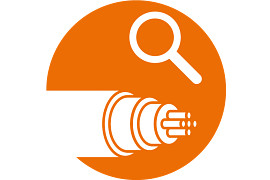
Product finder
Find exactly the right cable quickly

service life calculator
Calculate the service life of any chainflex® cable
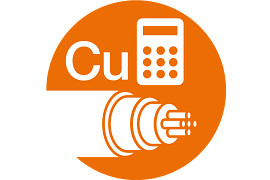
Copper surcharge calculator
Calculate the daily copper surcharge
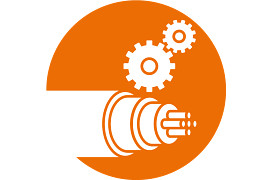
Configurator for customised cables
Configure your customised cable in just 3 minutes
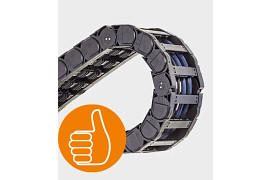
Are you still looking for an energy chain for your cable?
To the energy chains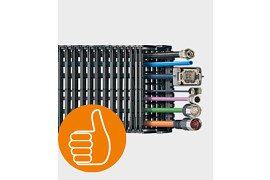
... or everything already harnessed?
To the readychainConsulting
I look forward to answering your questions

Katharina Wielpütz+49 2203 9649 7082Write e-mail
Shipping and consultation
In person:
Monday to Friday from 7 am - 8 pm.
Saturdays from 8 am- 12 pm.
Online:
24h
WhatsApp-Service:
Montag – Freitag: 8 – 16 Uhr